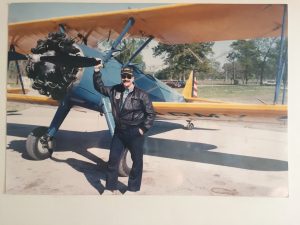Years ago, I purchased a Stearman biplane and flew it from Laconia, New Hampshire to St. Louis, Missouri. The Stearman is a WWII primary trainer, designated as PT17, affectionately known as the “Yellow Peril.” For me, the Stearman is a time machine transporting me to a simpler time of stick-and-rudder flying.
ago, I purchased a Stearman biplane and flew it from Laconia, New Hampshire to St. Louis, Missouri. The Stearman is a WWII primary trainer, designated as PT17, affectionately known as the “Yellow Peril.” For me, the Stearman is a time machine transporting me to a simpler time of stick-and-rudder flying.
A friend accompanied me as my navigator and copilot—I flew; he watched. Somewhere over the mountains of western New York state, he yelled into the Stearman’s primitive intercom, “Are you looking left?”
“Yeah,” I yelled back.
We flew another ten minutes, and he asked, “Are you looking right?”
“Yeah,” I replied.
After the next ten-minute leg, he asked, “Are you looking left, again?”
“Yes. Why do you keep asking me that question?”
“Because whichever way you look, we fly in that direction.”
We flew my line of sight. As I looked left, I unwittingly moved the stick left, tipping the ailerons and causing the left wing to fall. The airplane followed. If I looked right, my hand followed my line of sight and moved the stick right which tipped the wings in that direction. And, we flew off course, of course.
“What an amazing metaphor,” I thought! We moved along my line of sight. Because of my background in psychology, I knew that this is the foundation for the self-fulfilling prophecy: We believe in certain outcomes, and our beliefs set in motion activities that create the results we anticipated. These results confirm our initial expectations. If we don’t like the course of our lives, we can choose to change our line of sight and look for something better.
We become what we think about. We behave as we believe. We follow our beliefs, and the outcome of the behavior reinforces our beliefs. This self-reinforcing phenomenon works for both positive and negative beliefs. If I begin by believing that I will succeed, I have a greater probability of succeeding than if I begin with a negative expectation of the outcome.
In airplanes, attitude is that aircraft’s axial position relative to the horizon—nose up or nose down. The attitude of the plane determines if it flies level, climbs, or descends. So the lesson I learned is to keep my nose up, and if I don’t like the direction I’m flying through life, I need to check my line of sight, that is, my attitude, and throttle up.
Tom is the author of Hope in The Shadows of War, a novel about coming home from the Vietnam War.


Great article, Tom!
Thanks, Linda.